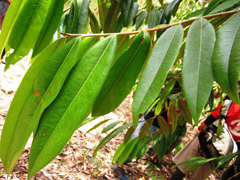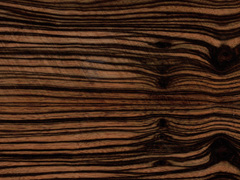 |
|
https://edibleplants.org/ |
 |
| https://edibleplants.org/ |
Translate this page:
Summary
Indonesian Ebony or Diospyros celebica is a flowering tree that reaches up to 40 m high upon maturity. It has a cylindrical buttressed bole of up to 150 cm in diameter. It is endemic to Indonesia, particularly in the island of Sulawesi. Due to this, it is also known as Makassar Ebony which is based on the main seaport of the island, Makassar. The wood is highly valuable and usually exported. It is used for turnery, cabinets, posts, musical instruments, etc. The fruit is edible.
Physical Characteristics

 Diospyros_celebica is an evergreen Tree growing to 30 m (98ft) by 30 m (98ft) at a slow rate.
Diospyros_celebica is an evergreen Tree growing to 30 m (98ft) by 30 m (98ft) at a slow rate.
See above for USDA hardiness. It is hardy to UK zone 10.
Suitable for: light (sandy), medium (loamy) and heavy (clay) soils and prefers well-drained soil. Suitable pH: mildly acid, neutral and basic (mildly alkaline) soils. It cannot grow in the shade. It prefers moist soil.
UK Hardiness Map
US Hardiness Map
Synonyms
Santalum myrtifolium (L) Roxb. Santalum ovatum R.Br. Sirium myrtifolium L.
Plant Habitats
Edible Uses
References More on Edible Uses
Medicinal Uses
Plants For A Future can not take any responsibility for any adverse effects from the use of plants. Always seek advice from a professional before using a plant medicinally.
None known
References More on Medicinal Uses
The Bookshop: Edible Plant Books
Our Latest books on Perennial Plants For Food Forests and Permaculture Gardens in paperback or digital formats.

Edible Tropical Plants
Food Forest Plants for Hotter Conditions: 250+ Plants For Tropical Food Forests & Permaculture Gardens.
More

Edible Temperate Plants
Plants for Your Food Forest: 500 Plants for Temperate Food Forests & Permaculture Gardens.
More

More Books
PFAF have eight books available in paperback and digital formats. Browse the shop for more information.
Shop Now
Other Uses
Other Uses: A very hard wood, the basic colour is black with brown lines, soft fibre and naturally shiny[ 325 ]. Ebony is a luxurious wood with high decorative and commercial value, it is commonly used for wood carving, furniture, house utensils, interior accessories, and building material[ 325 ]. We do not have any more specific information for this species. However, though varying widely in the relative proportion and the colouring of sapwood and heartwood, all the woods of the genus Diospyros are practically indistinguishable as regards their structure, as described below:-[ 721 ] Whether or not a given species produces heartwood depends largely on the size the tree has attained, but evidently also on other conditions, as there is a wide variation in the relative amounts of sapwood and heartwood even in individuals of the same species. When produced, the heartwood can be black with rosy, yellowish, brownish, or ashy streaks, sometimes it is nearly or totally black; it is generally sharply demarcated from the thin to very wide band of whitish, yellowish, or red sapwood. The texture is fine, smooth and (especially in the heartwood) very dense; the grain is generally very straight. The wood is hard to very hard; heavy to very heavy; the sapwood is tough and flexible whilst the heartwood is brittle; the heartwood is very durable, the sapwood moderately so. It is difficult to season well, logs almost invariably checking in several directions from the heart outward, while sawn lumber must be stacked carefully and weighted to prevent warping; once thoroughly dried, however, it becomes very stable. Its density makes it difficult to work, but it takes a beautiful surface under sharp tools[ 721 ]. Small trees containing little or no heartwood are used locally for posts, beams, joists, rafters, window sills, parts of agricultural implements, etc.; also, in lumbering, small poles are used for skids on account of their hardness, toughness and smooth wearing qualities. The heartwood (or sometimes sap and heart together) is used for scabbards, canes, hilts, tool handles, gunstocks, saw frames, etc.; it is a favorite for musical instruments, especially finger boards and keys of guitars; furniture, cabinetwork, inlaying; paper weights, inkstands and similar desk supplies; the sapwood, which is almost as hard as the heartwood and very much tougher, is an excellent material for T-squares and other drawing instruments, for shuttles, bobbins, spindles, golf-club heads and shafts, axe, pick, and hammer handles, etc[ 721 ].
Special Uses
References More on Other Uses
Cultivation details
A plant of the humid lowlands, where it is found at elevations up to 540 metres[ 325 ]. It grows best in areas where the mean annual temperature is between 22 - 28°c and the mean annual rainfall is 2,000 - 2,500mm[ 325 ]. Succeeds on various soil types - calcareous, clay and shallow stony soils[ 325 ]. It prefers relatively nutrient rich soil and is sensitive to water-logging[ 325 ]. The tree can commence flowering and fruiting when 5 - 7 years old from seed[ 325 ]. We have seen no individual confirmation for this species, but in general Diospyros species are dioecious and require both male and female forms to be grown if fruit and seed are required[ 899 ].
References Carbon Farming Information and Carbon Sequestration Information
Temperature Converter
Type a value in the Celsius field to convert the value to Fahrenheit:
Fahrenheit:
The PFAF Bookshop
Plants For A Future have a number of books available in paperback and digital form. Book titles include Edible Plants, Edible Perennials, Edible Trees,Edible Shrubs, Woodland Gardening, and Temperate Food Forest Plants. Our new book is Food Forest Plants For Hotter Conditions (Tropical and Sub-Tropical).
Shop Now
Plant Propagation
Seed - it has a very short viability and so should be sown as soon as possible[ 325 ]. The flesh should be removed since this contains germination inhibitors[ 325 ]. Sow the seed in a shady position in a nursery seedbed. The sowing media for ebony uses soil and fine sand at the ratio 3:1. The seed is planted horizontally or vertically with the radicle end down, with a sowing depth of 1 - 1.5 times the thickness of seed. Distance between the seeds is 3 - 5cm. Seeds are very sensitive to desiccation during germination and early growth, so must be regularly watered at this time[ 325 ]. Normally the seed will germinate after one week. In one trial, fresh seed, sown one day after collection, showed 85% germination rate within 17 - 65 days[ 325 ]. As a rule fresh seeds have a high percentage of fertility. The seedlings develop long taproots at an early stage, often before any appreciable elongation of the shoot takes place. The growth of the seedling is decidedly slow [ 652 ].
Other Names
If available other names are mentioned here
None
Native Range
TROPICAL ASIA: Indonesia (Sulawesi)
Weed Potential
Right plant wrong place. We are currently updating this section.
Please note that a plant may be invasive in one area but may not in your area so it’s worth checking.
Conservation Status
IUCN Red List of Threatened Plants Status : Status: Vulnerable A1cd

Growth: S = slow M = medium F = fast. Soil: L = light (sandy) M = medium H = heavy (clay). pH: A = acid N = neutral B = basic (alkaline). Shade: F = full shade S = semi-shade N = no shade. Moisture: D = dry M = Moist We = wet Wa = water.
Expert comment
Author
Bakh.
Botanical References
Links / References
For a list of references used on this page please go here
A special thanks to Ken Fern for some of the information used on this page.
Readers comment
| Add a comment |
|
If you have important information about this plant that may help other users please add a comment or link below. Only comments or links that are felt to be directly relevant to a plant will be included. If you think a comment/link or information contained on this page is inaccurate or misleading we would welcome your feedback at [email protected]. If you have questions about a plant please use the Forum on this website as we do not have the resources to answer questions ourselves.
* Please note: the comments by website users are not necessarily those held by PFAF and may give misleading or inaccurate information.
To leave a comment please Register or login here All comments need to be approved so will not appear immediately.
|
Subject : Diospyros_celebica
|
|
|
|